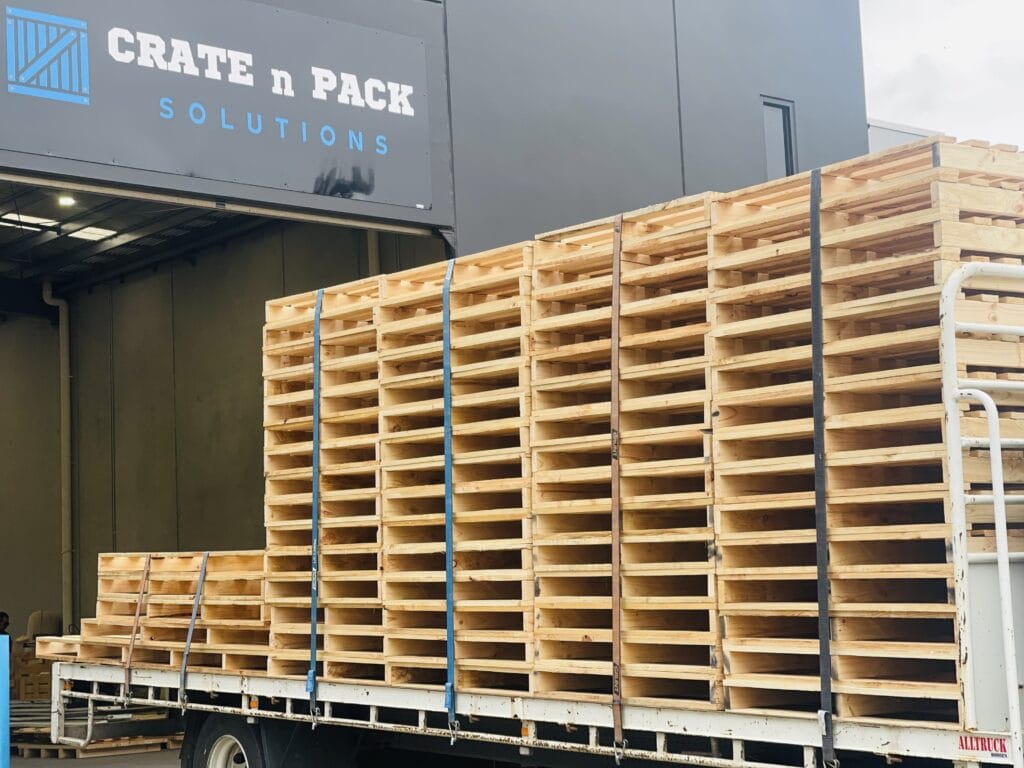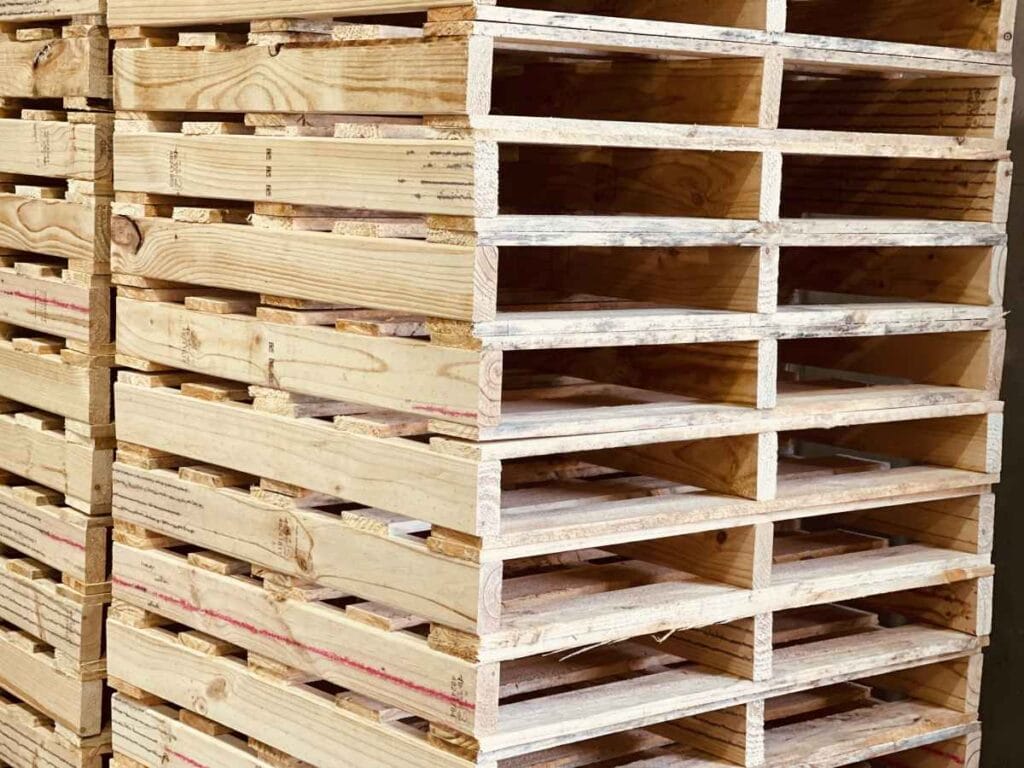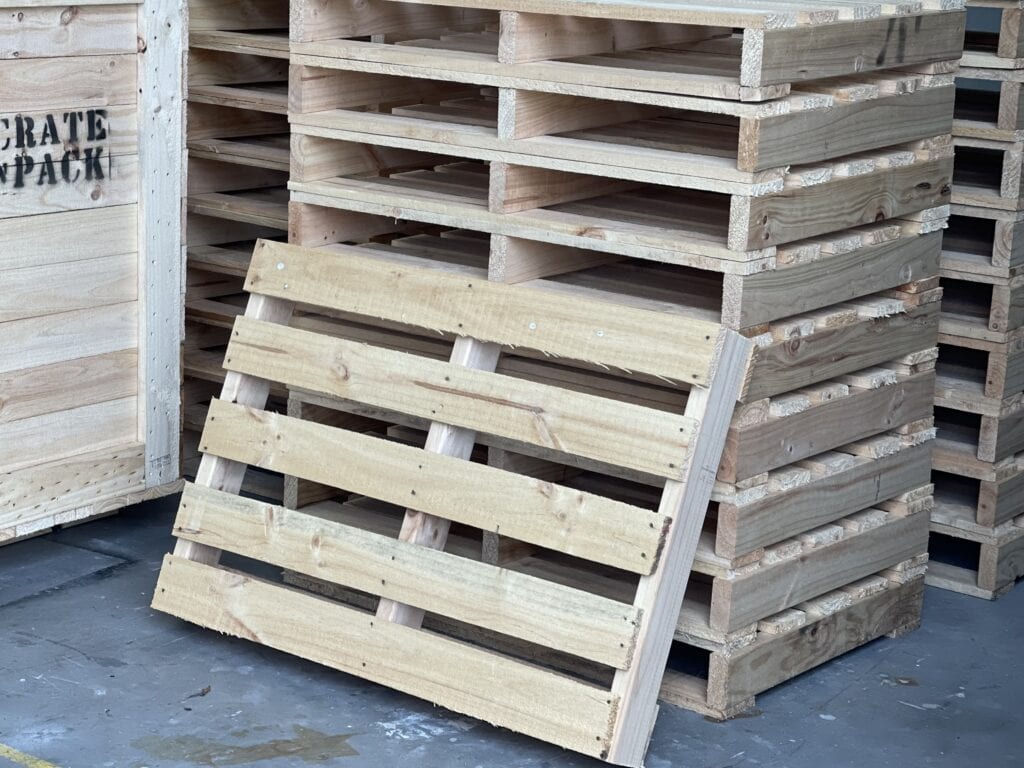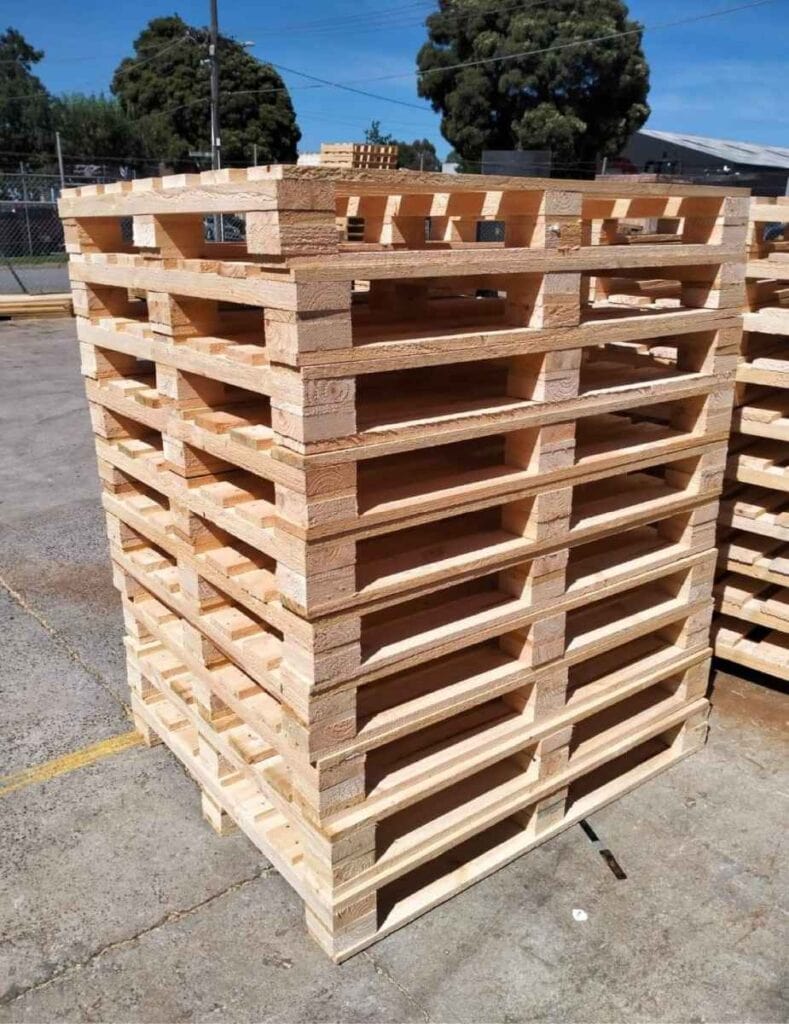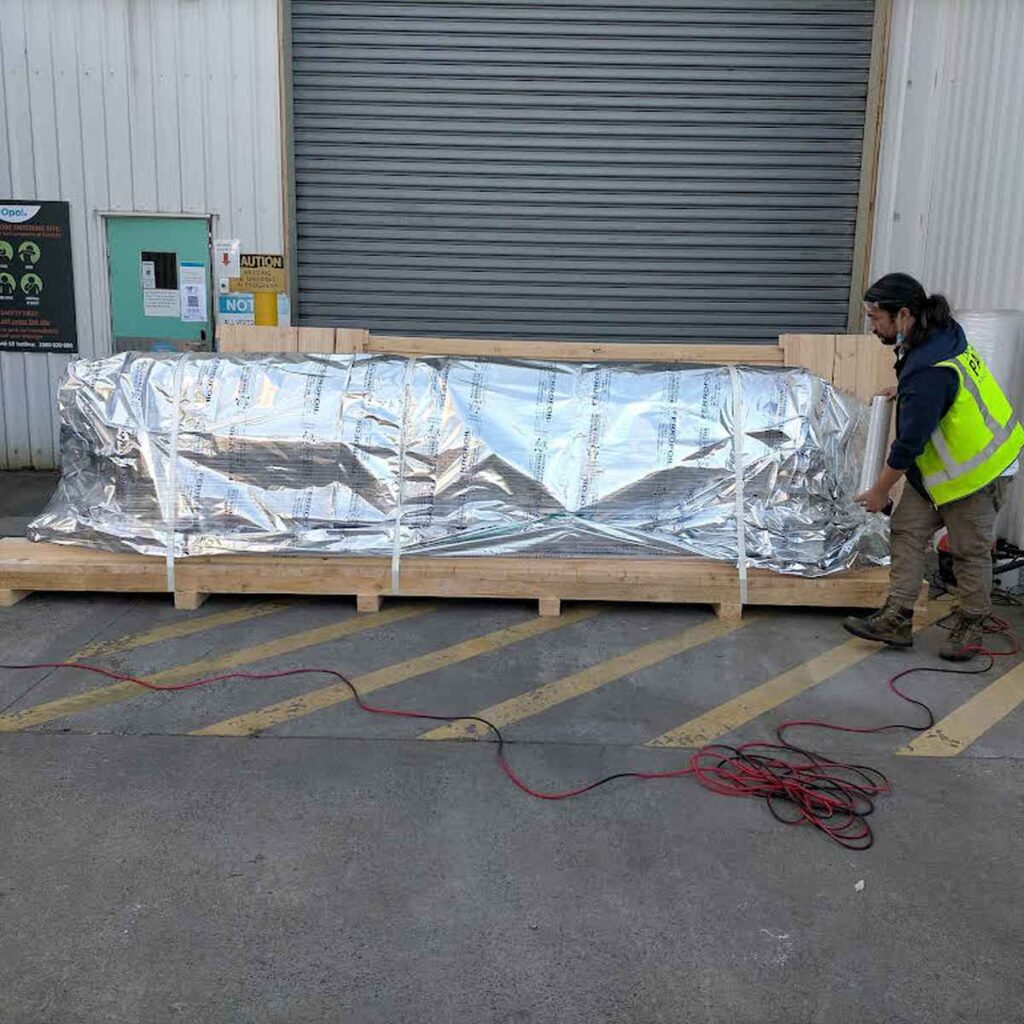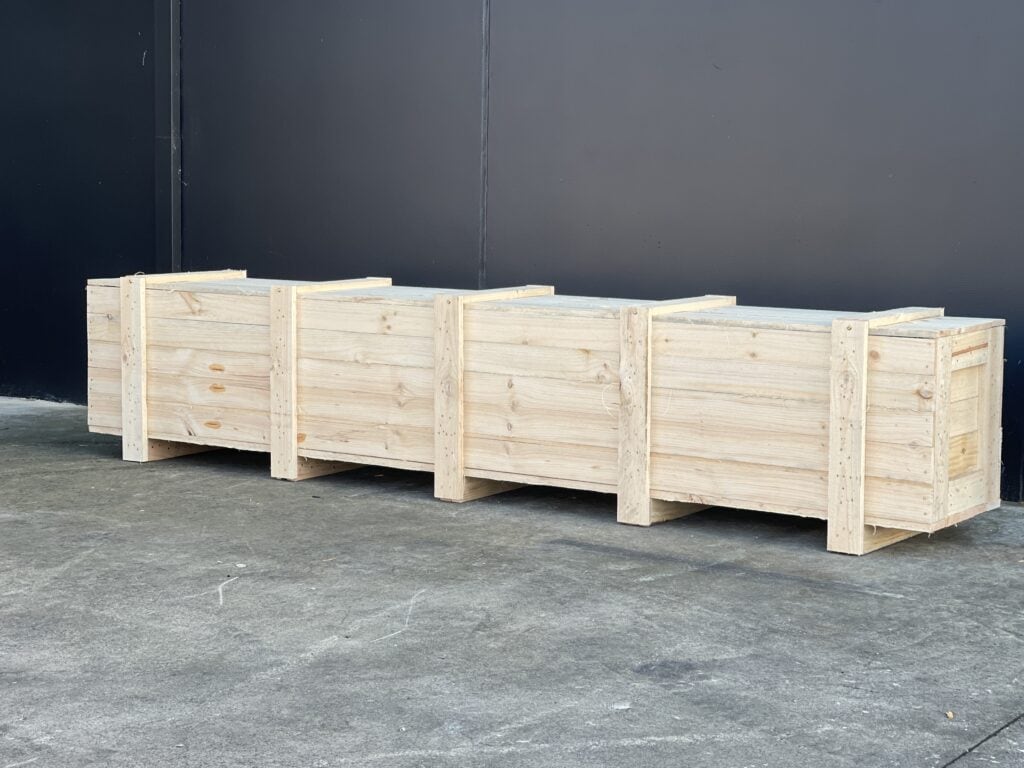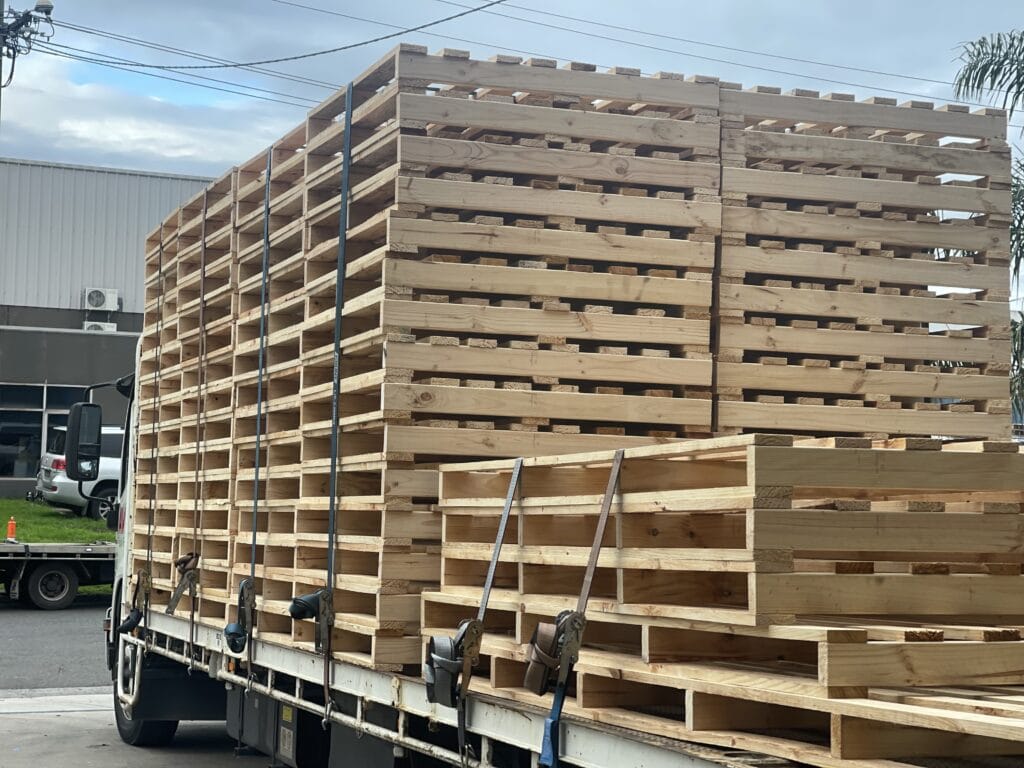Pallets made from heat-treated wood are required for international shipments of wood packaging materials. Heat treatment is an important part of ensuring that the items being shipped and the conditions at their final destination are safe.
These pallets are constructed from a renewable resource, the evergreen tree. Trees cannot flourish in an unnatural environment. All the nutrients and pests they need are in the soil they sprout from, the air they breathe, and the water they drink.
Unfortunately, it is all too common for pallet wood, where these pests live both as adults and larvae, to be shipped around the world.
In this comprehensive guide, we'll delve into the world of wooden pallets, uncovering why heat treatment has become a standard practice.
Why Are Pallets Heat Treated?
Wood is used to make about 90% of the pallets and skids used today for shipping goods worldwide. Given the massive volume of wooden packaging being shipped worldwide, there is a standard procedure to eliminate the risk of pest infestation. Customers that export goods to locations all over the world will find this to be especially important.
Each piece of hardwood packaging that goes through this treatment procedure bears a seal or mark recognised globally as proof that the item complies. This distinguishing feature acts as a passport, allowing the packaged item to travel across foreign boundaries without worrying about bringing in wood-borne pests.
As a result, the wooden packing may make its way through the international shipping and distribution system without any problems.
Heat Treated Pallets
Heat-treated pallets are vastly superior to their wooden counterparts in some ways.
Their increased steadiness guarantees the secure carriage of cargo while lowering the possibility of harm. In addition, they use fewer inputs in the manufacturing process, which is good for the environment. International shipping stamps on these pallets are recognised around the world, allowing for smooth cross-border commerce.
In addition, they are critical in preventing the spread of invasive species, which is important for protecting ecosystems. They are so sturdy that they can take a beating from frequent use without breaking down, allowing you to save money.
They are easier to handle and cheaper to freight because they weigh less. First and foremost, heat-treated pallets are more eco-friendly than traditional timber pallets since they are manufactured with sustainability in mind.
Standard Pallets
Standardised pallets, as they have been used until recently, have some drawbacks that make them inappropriate for international shipping and reduce their usefulness to enterprises. Their inability to obtain shipping certificates on a global scale limits their commercial potential.
Compared to heat-treated pallets, these are more difficult to move about, rot more quickly, and are less stable. Because of their low efficiency and short lifespan, organisations incur more expenditures when replacing them.
Standard pallets also entail extra shipping costs, which can put a strain on logistics budgets due to their heavier weight. Since typical pallets aren't ideal for running a business or shipping goods internationally, businesses are switching to more streamlined, universally accepted alternatives.
Advantages Of Heat-Treated Pallets
Heat-treated pallets offer a range of advantages that make them a preferred choice for various industries. These benefits include:
International Shipping Compliant
When it comes to logistics and international trade, heat-treated pallets stand out from the crowd. They are approved for international shipping and given the seal of approval. The absence of this stamp indicates that the pallets do not contain any pests or illnesses that could be harmful to ecosystems in their final destinations.
There can be costly interruptions in supply networks if pallets are delayed or rejected at ports because they need to. Therefore, having this stamp is essential for streamlined international trade and the preservation of global ecosystems.
Environmentally Friendly
Heat treatment stands out as an environmentally benign and sustainable alternative to chemical treatments. This approach is consistent with the ideals of ethical and environmentally conscientious business practices, as it does not involve potentially dangerous chemicals or pesticides.
Businesses may do their part to minimise their environmental impact and increase supply chain security by opting for heat-treated pallets. This environmentally responsible choice is crucial in reducing the release of hazardous compounds and protecting ecosystems.
By using heat-treated pallets, companies and the world are taking a concrete step towards a cleaner, more sustainable future.
Reduced Weight
The moisture content of the wood is reduced through the heat treatment procedure, which results in a clear benefit: the pallets weigh less. If you're shipping a few pallets, the difference in weight might not seem like much, but it adds up quickly when you're moving a lot of stuff.
Companies that have to ship many pallets at once might save money and time because of the cumulative weight decrease.
Less gasoline is needed to move lighter pallets, consistent with sustainability goals of reducing fuel costs and carbon emissions.
Since the advantages of heat-treated pallets go beyond individual shipments, they are an economical and ecologically sound option for organisations with extensive logistics requirements.
Increased Workplace Safety
Pallets subjected to heat treatment provide benefits in two areas: product security and employee health and safety. Because heat treatment typically leaves no chemical residues, it poses no risk of exposing workers to harmful compounds.
This essential safety component helps make the workplace healthier and safer for employees. Workers will be able to go about their work without worrying about being exposed to harmful chemicals, which will cut down on the number of potential injuries and illnesses.
Choosing heat-treated pallets isn't only about ensuring the safety of your products; it's also about protecting your company's most valuable asset: its employees.
Less Resistant To Mould And Bacteria
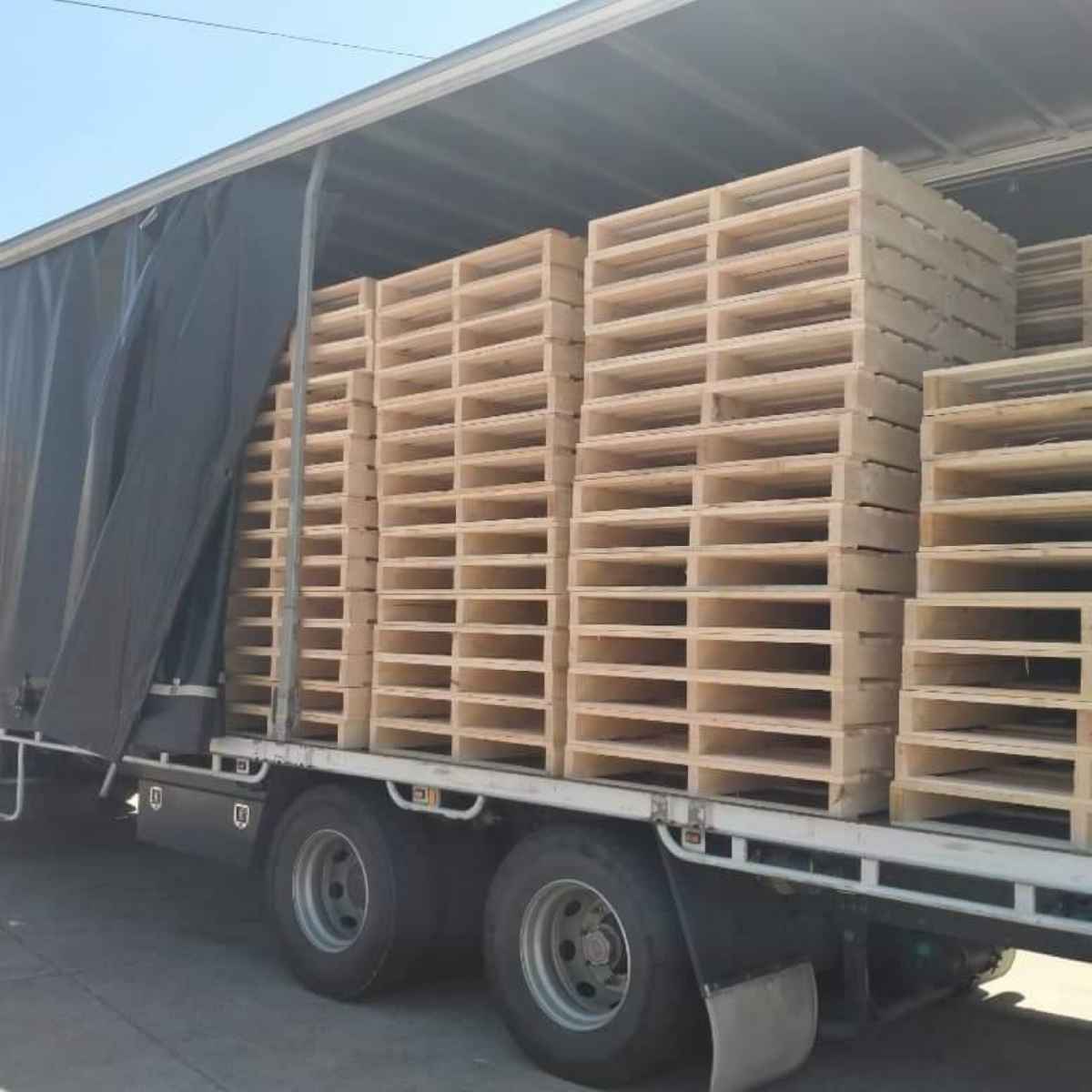
Since wood is porous, it absorbs moisture easily and becomes a breeding ground for mould in humid settings. Mould might not cause much damage to the wood, but it is a hidden danger since it can spread to whatever is being moved or stored in the wooden containers. An efficient solution to this problem is the heat treatment technique.
The treatment involves exposing wood to regulated heat, which effectively removes moisture from the wood's pores, making the wood far more resistant to the damaging effects of humidity and dampness. As a result, sectors where moisture management is crucial may trust heat-treated wood since it protects the integrity of the packing material and the items it contains.
Pest Control
Heat-treated pallets are subjected to elevated temperatures in a carefully monitored treatment facility. The primary goal of this process is the extermination of any insects or other pests that may be hiding within the timber structure.
These potential dangers are effectively eradicated by high heat, guaranteeing that no dangerous pests exist in the pallets.
This precise method of pest management has far-reaching repercussions for the shipping and warehousing of commodities. Heat-treated pallets are essential for maintaining product safety and cleanliness since they eliminate the possibility of pest infestations.
By using these pallets, industries can ensure that their products are safe from contamination and will arrive at their clients in pristine condition.
Improved Longevity
Putting wooden pallets through a heat treatment dramatically improves their resilience and service life. These treated pallets have increased resistance to rot and decay, protecting them from the inevitable breakdown of untreated wood pallets over time.
This longer service life is a major benefit, especially for companies that use pallet systems regularly. Using heat-treated pallets significantly reduces maintenance costs and downtime.
Since this is a long-term benefit, it results in significant savings. Businesses can maximise their expenditures and improve efficiency by reallocating resources that normally go towards continual pallet buying to other crucial areas of their business.
Businesses and the environment may benefit from the long-term, sustainable solution to pallet management that heat-treated pallets provide.
Disadvantages Of Heat Treatment
While heat treatment offers several advantages, it also has some disadvantages to consider:
Added Cost
It's no secret that the price of treated pallets is higher than that of untreated ones.
The price of conventional hardwood packing must be increased because of the extensive measures taken to assure pest control and durability throughout the treatment process.
This additional expense may cause some worry at first, but it must be considered.
The initial cost of investing in treated pallets may be outweighed by their advantages, such as increased product safety, increased durability, and decreased environmental effects.
In addition, when the possible downsides and costs associated with untreated pallets are taken into consideration, such as damage caused by pests or the need for regular replacements, the initial cost of treated pallets can be justified as a smart and cost-effective long-term solution.
Buying treated pallets may seem pricey at first, but over the course of their long service life, they will provide reliability, sustainability, and peace of mind.
Time-Consuming
Heat treatment, while quite effective, is a time-consuming process.
Pallets have certain temperature requirements that must be fulfilled and sustained for a set amount of time, necessitating careful attention to detail.
Though necessary for its benefits, this comprehensive treatment regimen might need help in pallet production and supply chain management.
The potential for longer lead times in pallet production is one significant effect.
This holdup threatens the smooth operation of the supply chain and can cause commodities to back up.
Heat treatment takes a long time, which can be a problem in industries that value speed and reliability because it requires extra planning to avoid delays.
It is important to keep in mind that the long-term advantages of heat-treated pallets, including increased durability, pest management, and environmental responsibility, usually outweigh the short-term hassle.
Long-term supply chain reliability and quality assurance are two areas where many companies see the value in investing time upfront.
Sourcing
Heat-treated pallets are an optional extra not provided by all shipping carriers. For companies needing this packing for their shipments, this facet of pallet selection adds another layer of difficulty. Effectively navigating this obstacle will require thorough preparation and analysis.
It may be necessary for companies that want to use heat-treated pallets to seek out reliable shippers that can meet their needs.
Contacting potential shippers, looking through their services, and ensuring they meet international requirements for heat-treated pallets is a typical first step in this procedure.
This extra study and work may seem like a hassle, but it's necessary to ensure your shipping requirements are consistent with your sustainability and quality control goals.
Choosing a logistics provider that offers heat-treated pallets is an excellent way to demonstrate your company's dedication to socially and environmentally responsible methods throughout shipping.
Limited Effect On Existing Pallets
When heat treatment is applied in the life cycle of wooden pallets and packing materials, it greatly impacts the products' safety and quality. New pallets and wooden packaging materials typically undergo heat treatment as part of the production process to ensure they are durable and free of pests.
When applied to old pallets subjected to various conditions and potential pollutants over time, heat treatment may lose some of its efficacy.
For companies with a sizable number of preexisting wooden pallets, this could offer a problem.
Switching to heat-treated pallets may be difficult and expensive if the current pallets must be gradually phased out and replaced.
While switching to heat-treated pallets could be difficult for certain organisations, good planning can help smooth the way.
A phased introduction of new pallets is one option, as is investigating recycling and refurbishment possibilities for currently used pallets.
A company's choice to switch to heat-treated pallets should be made after careful consideration of its sustainability objectives, supply chain requirements, and available resources.
High Moisture Resistance Is Limited
Heat treatment is an effective strategy for removing mould and protecting the structural integrity of wooden pallets. Heat-treated pallets show remarkable resistance to many environmental variables, but it's important to remember that they may not be completely immune to high amounts of moisture. Still, warping and swelling can occur if a pallet is left damp for an extended period of time.
Industries operating in consistently high humidity levels should look into other treatments or materials for their pallet requirements. Consider looking into alternate options, such as plastic or metal pallets, which are naturally more resistant to moisture. It may also be worthwhile to look into the possibility of using treated or coated wooden pallets to increase their resistance to moisture.
Heat-treated timber pallets are one option, but the industry's needs and the conditions to which the pallets will be subjected should ultimately dictate the decision. To ensure the lifetime and dependability of pallets in severe moisture-prone locations, it is crucial to strike the correct balance between cost-effectiveness, durability, and moisture resistance.
Conclusion
Wooden pallets are heated to make sure they can be shipped internationally safely and to keep pests from getting into them. The evergreen tree, which is used to make these pallets, is a renewable resource that can grow in places that aren't natural. Heat-treated pallets are better for the environment than wood pallets because they last longer, are easy to move, and cost less to ship. They also require less material to make, which makes them better for the earth.
Standard pallets have problems, like being hard to move around, rotting more quickly, and being less stable. They also cost more to ship and are less effective. Heat-treated pallets have many benefits, such as being legal for foreign shipping, good for the environment, and affordable. They are approved for foreign shipping and get a seal of approval. This keeps supply networks from going down, which can be very expensive.
Heat-treated pallets are also good for the earth because no chemicals or pesticides are used. This choice is good for the environment because it helps companies reduce their negative effects on the environment and improve the safety of their supply chains. This contributes to a cleaner, more sustainable future. Businesses and the world as a whole are taking a step towards a cleaner, more sustainable future by using pallets that have been heated.
The heat treatment of wood pallets has many benefits, such as making them lighter, making the workplace safer, making them less resistant to mould and germs, making them less attractive to pests, and making them last longer.
The amount of water in the wood is reduced, which makes the pallets lighter.
This can save money and time for companies that ship multiple things at once. Heat treatment also makes it less likely that workers will be exposed to dangerous chemicals, which makes the workplace healthier and safer.
Pests can also be killed by heat treatment, which protects both the packaging and its contents. This method is especially helpful in areas where managing wetness is important. Heat-treated pallets are also less likely to rot or decay. This cuts down on upkeep costs and downtime, which saves businesses a lot of money.
But heat treatment has some downsides, like costing more.
Even though the cost of treated pallets may seem high at first, they are a cost-effective long-term option because they make products safer, last longer, and have less of an impact on the environment.
Treated pallets are reliable, last a long time, and give you peace of mind over their long working life. Overall, heat treatment is a long-lasting and cost-effective way to handle pallets.
Heat treatment is a process that takes a lot of time and requires careful attention to detail.
This can make it take longer to make pallets and handle the supply chain.
But the long-term benefits of heat-treated pallets, like making them last longer, keeping pests away, and being good to the environment, usually beat the short-term hassle. Shippers might not have heat-treated pallets, which makes it hard for businesses to choose trusted shippers.
Heat treatment changes the safety and quality of current pallets, but it may lose some of its effectiveness over time if it is used on old pallets that have been exposed to different conditions and possible pollutants.
Switching to pallets that have been heated may be hard and expensive, but good planning can help make the change go more smoothly.
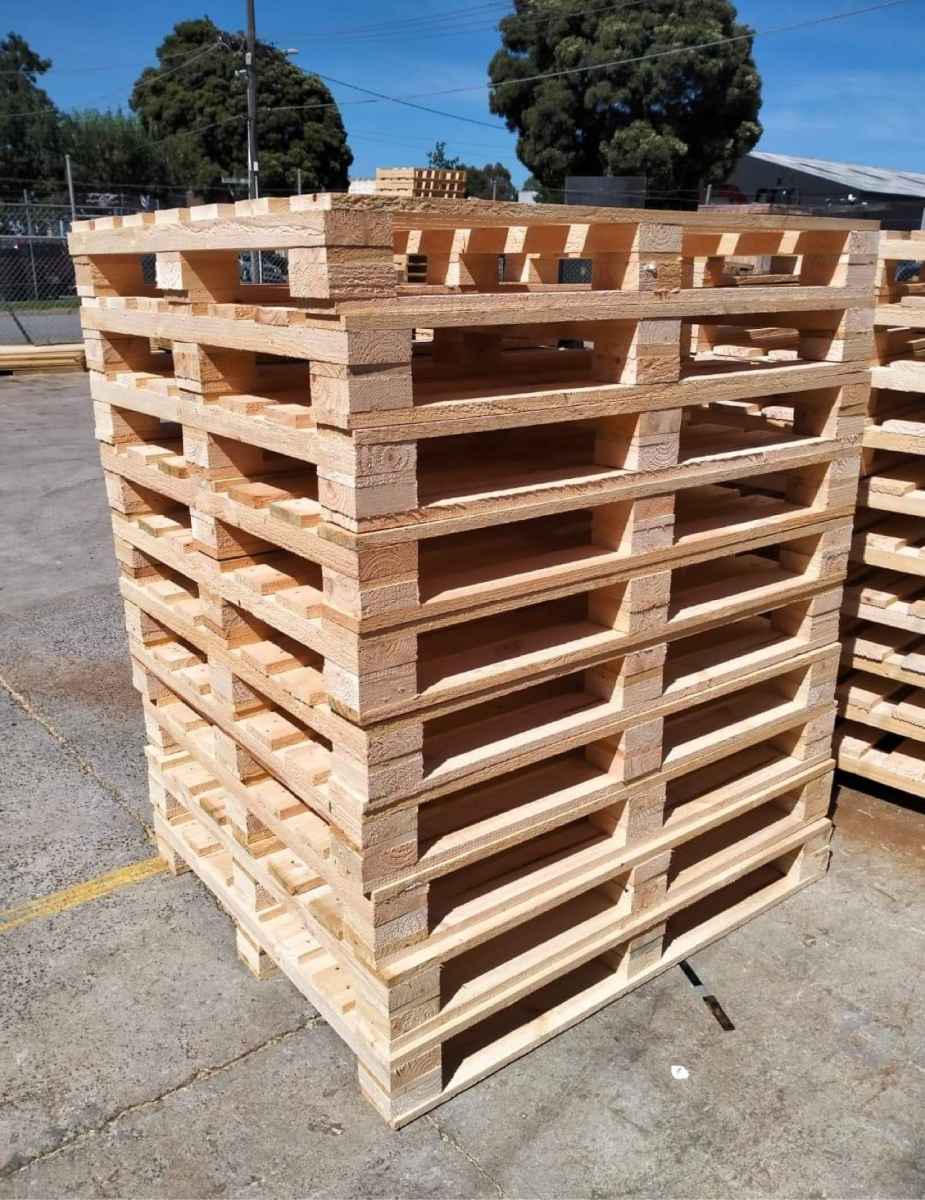
High moisture resistance isn't very good, so businesses that work in areas with high humidity levels all the time should think about using other treatments or materials, like plastic or metal pallets or wooden pallets that have been treated or coated. In the end, the choice should be based on the needs and conditions of the industry. For pallets to last and be reliable in places where there is a lot of moisture, there needs to be a balance between cost-effectiveness, durability, and moisture resistance.
Content Summary
- Heat-treated wooden pallets are required for international shipments to ensure safety and prevent pest infestation.
- Heat treatment serves as a standard procedure globally for wooden pallets used in shipping.
- The heat-treated pallets bear a globally recognised mark or seal that serves as a "passport" for international shipping.
- Wooden pallets are made from renewable resources, primarily evergreen trees.
- Heat-treated pallets are less prone to damage and are more stable compared to non-treated pallets.
- These pallets are eco-friendly and are designed with sustainability in mind.
- They play a crucial role in preventing the spread of invasive species and protecting ecosystems.
- Heat-treated pallets weigh less, making them easier and cheaper to freight.
- They are more durable, thus saving companies money in the long run.
- Standard pallets have limitations, including their inability to be globally certified for shipping.
- Compared to heat-treated pallets, standard pallets are less stable and prone to rotting.
- Standard pallets add extra costs to shipping due to their heavier weight.
- Heat-treated pallets are compliant with international shipping regulations thanks to a globally recognised stamp.
- These pallets contribute to streamlined international trade and help preserve global ecosystems.
- Heat treatment is an environmentally friendly alternative to chemical treatments.
- Companies choosing heat-treated pallets are making an environmentally responsible choice.
- These pallets are lighter due to reduced moisture content, contributing to lower fuel costs and carbon emissions.
- Heat-treated pallets are safer for employees as they leave no chemical residues.
- They are less prone to mould and bacterial growth due to their reduced moisture content.
- The heat treatment process kills off any pests, making these pallets safe for product storage and shipping.
- The pallets have a longer lifespan, which results in significant savings for businesses.
- One downside is that heat-treated pallets are more expensive initially than untreated ones.
- However, the long-term benefits usually outweigh the initial costs.
- Heat treatment is time-consuming, requiring careful attention to temperature requirements.
- This time-intensive process can cause delays in supply chains.
- Not all shipping carriers offer the option of heat-treated pallets.
- Companies need to do extra research to find shippers who provide this service.
- Heat treatment can lose some of its effectiveness when applied to older, preexisting pallets.
- Companies may need to phase out older pallets gradually, which could be expensive.
- Heat-treated pallets are not entirely immune to high moisture conditions.
- Industries in high-humidity areas might need to consider other materials like plastic or metal pallets.
- Heat treatment contributes to increased workplace safety by eliminating chemical residues.
- The pallets are suitable for sectors where moisture management is crucial.
- They are vital for maintaining product safety and cleanliness during shipping and storage.
- Heat-treated pallets are more efficient, reducing the need for frequent replacements.
- Their light weight contributes to more cost-effective shipping and lower carbon footprints.
- They support ethical and environmentally conscientious business practices.
- Businesses can reallocate resources saved from pallet maintenance to other areas.
- The treatment process effectively removes moisture from wood pores.
- Heat-treated pallets are consistent with sustainability goals of reducing fuel costs.
- The long-term benefits of using these pallets often justify the time invested in heat treatment.
- Businesses must align their choice of pallets with their sustainability and quality control goals.
- Their global recognition facilitates smooth cross-border commerce.
- A phased introduction of heat-treated pallets can ease the transition for companies.
- These pallets can withstand frequent use without breaking down, offering economic advantages.
- Companies may have to seek out specific shippers who can meet their needs for heat-treated pallets.
- Businesses using heat-treated pallets contribute to a cleaner, more sustainable future.
- These pallets ensure that products are safe from contamination and arrive at their destination in pristine condition.
- Despite their higher initial cost, heat-treated pallets offer reliability, sustainability, and peace of mind.
- The choice of pallet type should consider cost-effectiveness, durability, and environmental impact.
Frequently Asked Questions
Yes, heat-treated wooden pallets can be reused and recycled. When they reach the end of their life cycle, they can be repurposed into other wooden products or used as biomass fuel, reducing waste and conserving resources.
Due to the additional processing, heat-treated pallets may be slightly more expensive than non-treated ones. However, their extended lifespan and compliance with international standards often make them a cost-effective choice for businesses engaged in international trade.
Yes, heat-treated pallets offer environmental benefits. They reduce the need for chemical treatments, which can harm the environment. Their recyclability and reduced waste also contribute to a more sustainable supply chain.
Different countries have regulations regarding wooden pallets, especially for international trade. It's essential to be aware of these regulations and ensure your pallets comply. Heat-treated pallets often meet these requirements.
Yes, heat-treated pallets offer health and safety benefits. By eliminating pests and pathogens, they reduce the risk of contamination of goods during transportation, making them safer for consumers and workers in the supply chain.


